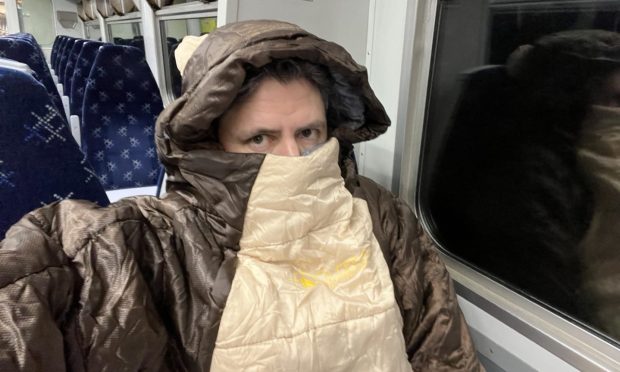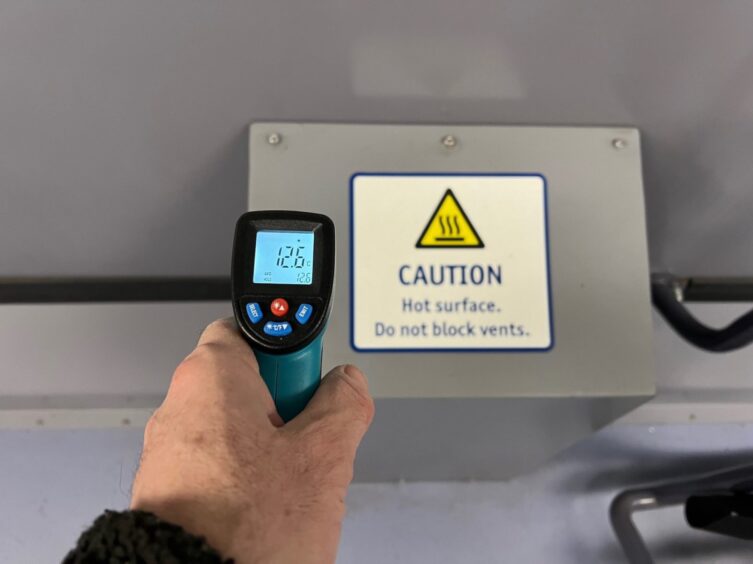A teacher has told how he has taken to wearing a sleeping bag on the train between Oban and Glasgow in a bid to keep warm.
Martin Douglas, a music teacher from Inverawe, recorded a temperature of 12.6C on ScotRail’s West Highland Line service, nicknamed the Polar Express.
While there is no law in place for minimum temperatures on trains, the UK Government guidance suggests a minimum of 16C for workplaces.
Mr Douglas, 52, said he regularly makes work trips on the train – and would use the bus, but the times of the alternative transport means he would not be able to get to work on time.
He said: “It is like the Polar Express on the train.
“I am a two-jacket person and even that is not enough to keep warm.
“There are so many people who have complained about the train over the years, and eventually they have given up – and are probably now using other transport.”
Another passenger told The P&J staff encouraged them to “to put on more clothes for the journey” when the temperature plunged to 10C.
The train is frequently used by West Coast residents who have hospital appointments in Glasgow.
Mr Douglas continued: “The problem is that the train is made of metal, and there is no insulation on the trains.
“The heaters blow out hot air – but because the train is so badly insulated it goes nowhere. It just does not keep people warm.
“Fans that are meant to circulate hot air do not appear to work.”
He continued: “While I think there are things that could be done to improve the trains we have – they were brought onto service in 1989 and it is time for new carriages on the route.
“The trains have been refurbished but it has not improved matters.
‘Polar Express’ nickname for Oban to Glasgow West Highland Line
“You can not expect people to travel in such chilly conditions.
“The seals around the windows and doors have perished over time, and so there is no way of keeping the heat in the train.”
Jean and Phil Glen, who were visiting the area, said they tried to close a door on the train to keep warm, but realised there were no doors on one end of the train.
Mr Glen, who travelled up in late December, said: “The trains to Oban are on one of the most outstanding lines in the world – but there is just no way to keep warm aboard the train.
“We tried to close a door on the afternoon train to heat up – and found it wasn’t there.
“We closed another door and were told off by the conductor as it was then stuck and no one could open it.
“It is a sorry story when you come to Oban and you are cold for the journey of more than three hours – it puts you off using the train.”
ScotRail said that trains can take some time to heat up, as the system operates on excess heat from the engine.
A ScotRail spokesman said: “Our fleet of class 156 trains which operate on the West Highland Lines are heated by the excess heat provided by the engine.
“As you’d expect, the train gets cold overnight and can take some time to heat up, particularly in the winter months – the interior of a train is much larger than a car.
“There are noise considerations at both Oban and Mallaig which prevent the engine being ‘run up’ unnecessarily in the early hours (the engine needs to be revved to build up heat).
“Furthermore, there is also the issue of staff availability to start up the train in advance for the very first trains.”
He said that this year ScotRail had initiated a comprehensive maintenance check prior to winter to make sure the heaters are working correctly which has “resulted in improved customer comfort”.
ScotRail apologise for freezing temperatures
In the longer term, ScotRail said it would “investigate funding for a replacement of the heating system, however, there is a significant cost associated with this”.
David Lister, ScotRail safety, engineering and sustainability director, added: “We’re sorry to customers who have experienced discomfort during their journey as a result of cold temperatures on board our trains in the West Highlands.
“We know that the Scottish winter can make heating the first train of the day before departure very challenging.
“Our staff are working tirelessly to ensure our trains are operating as reliably as possible.
“We continue to look into longer-term solutions and funding options which could improve onboard temperatures for our passengers. ”

